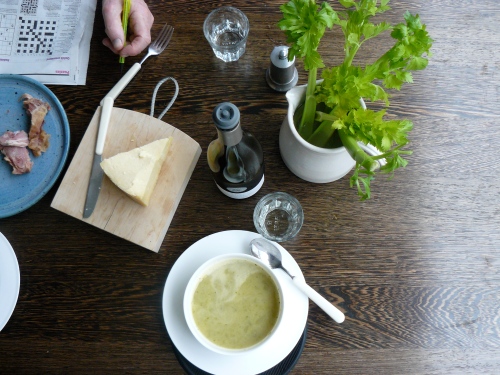
The jar of pesto I was so happy to have sitting in the fridge, the green and basily one, the one Vincenzo patiently pounded in the pestle and mortar is – as Alison Krauss sings so beautifully- gone gone gone.
Of course it has.
The last spoonful was maybe the best.
It was the final dollop on something which would have been perfectly delicious without it, a plateful of earthy, nutty lentils with a handful of sweet green peas, some fragrant basil leaves topped with 2 and a half slices of soft, creamy goats cheese.
There is something about this combination, the lentils are soft and hearty, the peas pop with fresh sweetness. the cheese is creamy, fudgy and just a little acidic, melting and softening just a little with the warmth of the peas and lentils and the pesto gives everything a velvety, basil filled kick.
This is Nigel Slaters recipe which caught my eye a while back and then buzzed around my head nagging me to make it every-time I saw a pea – which was pretty much a daily occurrence now the market is full of delightful green pods at this May moment.
Nigel recommends a straightforward boil for the lentils, but I cooked them as I usually do with a carrot, a stick of celery, an onion, a bay leaf and several whole black peppercorns because I love the depth of flavour that emerges when you cook lentils this way.

I fear I am always declaring my new favorite lunch – which is by far my favorite meal – and today is no exception.
Nice bread is nice with this
It is even nicer with a glass of Verdicchio dei Castelli di Jesi.
Goats cheese, pea and lentil salad with pesto.
Adapted from Nigel Slater’s recipe
Serves 2 for lunch or supper or 4 as a starter
150g small green lentils such as de Puy
200g shelled peas
a small bunch of fresh basil
olive oil- 2 tablespoons and a little extra
pesto
12 slices goats cheese
Rinse the lentils in a sieve under running water and then tip them into a pan of
boiling, lightly salted water (with or without the addition of a carrot, celery, bay leaf, onion and 3 peppercorns). Leave them at an enthusiastic simmer for
about 15-20 minutes until they are tender, then drain, tip into a bowl and
stir the 2 tbsp olive oil through them.
Boil the peas in lightly salted water till bright and tender, drain
under cold running water and mix with the lentils.
Tear the basil leaves into small pieces and stir them into the lentils
Dribble over more olive oil and season a little salt and pepper.
Divide the goats cheese and salad between 4 plates.
Put a blob of pesto on each plate.
Eat.












